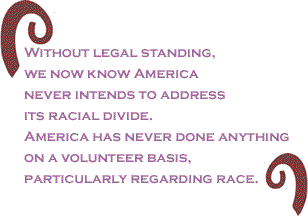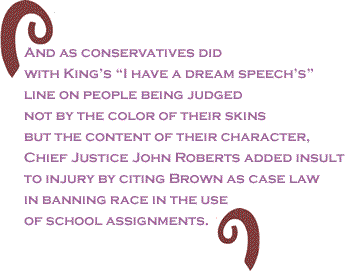
|
|||||||||||||||||||||
|
||||||||||
|
The current issue is always free to everyone If
you need the access available to a |
||||||||||
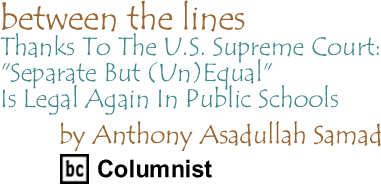 |
||||||||||
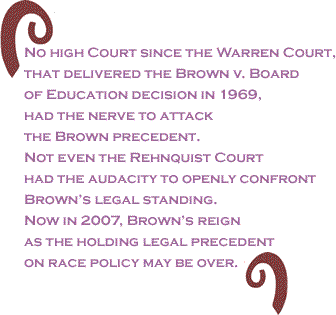 |
||||||||||
The United States Supreme Court ruled last week that public education officials may not use race to achieve integration in public schools. Yes, you heard it right. After 52 years, the high Court reversed itself on the venerable case of Brown v. Board of Education, five separate cases consolidated under one oral argument—then called “the Segregation cases.” In 1954, the U.S. Supreme Court ruled that segregated school systems were inherently separate and unequal and thus unconstitutional. A year later, they put forth the implementation order, under a “With All Deliberate Speed” decree to desegregate which took all of two decades in some parts of the country. To end the Massive Resistance (a whole organized movement in 11 states), the Court ultimately was forced to take control of many school districts throughout the nation and put in place “integration plans” to achieve racial balance. While many of the southern school districts successfully desegregated, many northern school districts, including Los Angeles, Boston and Detroit never achieved racial balance and had to resort to volunteer plans. Those haven’t worked either. The few school districts that had worked out suitable policy methods to achieve racial balance had their policies challenge under the nation’s “colorblind” culture. Once considered off-limits, Brown has stood the test of time, holding even in the most adverse reverse discrimination cases of Bakke v. University of California Board of Regents in 1978 and Gutter v. Bollinger in the challenges to the University of Michigan’s Law School in 2003. No high Court since the Warren Court, that delivered the decision in 1969, had the nerve to attack the Brown precedent. Not even the Rehnquist Court had the audacity to openly confront Brown’s legal standing. Now in 2007, Brown’s reign as the holding legal precedent on race policy may be over. In two separate school cases—in Seattle, Washington and Louisville, Kentucky—in what could be called “the Integration Cases,” The Supreme Court ruled that school districts could not uphold integration policies that put a child’s equal to attend home schools ahead of diversity. The challenge here was that white students in each case were preventing from attending the schools of their choice. Their exclusion from their home district schools, because other minority were included by district policies, violated to 14th Amendment’s equal protection clause, the Court said. The same legal premise that was used to uphold cases in California, Texas and Michigan-but acknowledged Brown and the institution’s right to include the historically discriminated, dismissed Brown in the Seattle and Louisville cases, except to say that the legacy of Brown called for the elimination of school based assignment based on race. That was not the legacy, nor the intent of Brown. The legacy of Brown was the elimination of disparate schools based on disparate resources that were tied to race. Black children didn’t want to go to white schools just because they were white. They wanted to go the schools that were better resourced than theirs, and coincidentally happened to be white—which of course, their parents knew, the school districts knew and the Courts knew.
Justice Steven Breyer in his dissenting opinion called Brown the U.S. Supreme Court’s “finest hour,” but acknowledged that the mission of racial equality has yet to be fulfilled. America is the world’s most racial nation, but always wants to run from its race realities—largely because it never wants to face up to its racial past. Brown made America acknowledge its racial past, and its intent was to help the nation correct it. But the nation has continued to run from it by avoiding race or any type of race consciousness policies that makes it face up to its past. Now the relativist politic that dominated the executive and legislative branches and said race no longer mattered now has found traction in the high Court. Without legal standing, we now know America never intends to address its racial divide. America has never done anything on a volunteer basis, particularly regarding race. The clock has been officially turned back as the Supreme Court voted 5-4 to eliminate “race-conscious measures” to enforce diversity. And as conservatives did with King’s “I have a dream speech’s” line on people being judged not by the color of their skins but the content of their character, Chief Justice John Roberts added insult to injury by citing Brown as case law in banning race in the use of school assignments. Associate Justice John Paul Stevens called Robert’s opinion in evoking Brown as a justification of the Court’s majority holding, a “cruel irony.” An even crueler irony is that, once again, “Uncle Clarence” Thomas, probably the most significant beneficiary of the intent of Brown on the high Court—an admitted beneficiary of affirmative action, and a resident of Virginia whose anti-miscegenation laws were overturned by the Lovings decision that was based on Brown’s anti-separation, full equality case law forty years ago in 1967, which wouldn’t have allowed Thomas to date a white woman much less marry one, sided with the majority (again). Though the post decision analysis posits Justice Anthony Kennedy as the swing vote in this new decision, because he concurred on a different principle that suggested the Brown principle of bringing students together and the important work of achieving diversity should not be abandoned, we know that Clarence Thomas continues to be the biggest betrayer of the legal entrustment of the Courts protecting Blacks’ fifty year fight for real equality, and continues to be a leading voice, as silent as he is, in the deconstruction of the gains of the most significant social movement America ever saw. Still, we believed that not even this “toming” Thomas would be fool enough to attack the case law enabled him to get to the U.S. Supreme Court. How wrong we were.
Still, there is optimism in ashes of the house we once knew as the indefeatable Brown case. Brown scholar, and legal theorist, Charles Ogletree, the curator of the memory of the architect of Brown, as Executive Director of the Charles Hamilton Houston Institute for Race and Justice at Harvard Law School, wrote an Op-Ed piece in the Boston Globe a day after the decision that said “Brown’s legacy lives, But barely.” Understand the colorblind politic that drives our society. The door has been cracked for every school district that has an integration plan to now challenge it. If we think that voluntary integration will occur, at a critical time when resegregation is the order of the day all over the nation, then we haven’t done a very good job of studying America’s racial past. It’s safe to say, at least for the time being, that the “All Deliberate Speed” order of Brown II that had slowed to a crawl in the past twenty-five years-but was still moving, has come to a stop. BC Columnist Dr. Anthony Asadullah Samad is a national columnist, managing director of the Urban Issues Forum and author of the upcoming book, Saving The Race: Empowerment Through Wisdom. His Website is AnthonySamad.com. Click here to contact Dr. Samad. |
||||||||||
| July
5, 2007 Issue 236 |
|
| Printer Friendly Version in resizeable plain text format |
 |
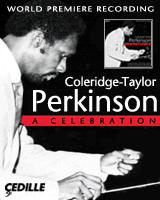 |
 |
| |
| |
























